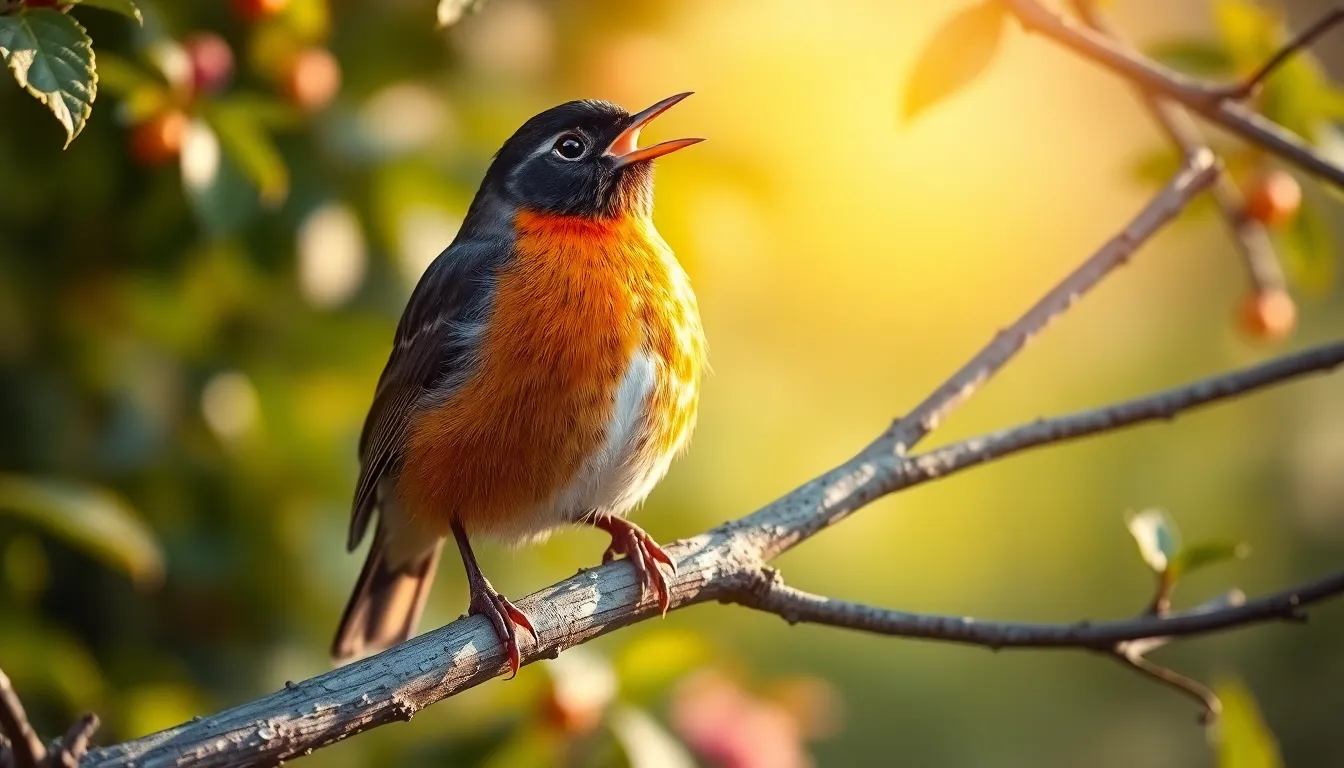When it comes to the symphony of nature, few voices stand out quite like the cheerful robin. With its bright red breast and charming demeanor, this little bird is a beloved harbinger of spring. But what does a robin really sound like? If you’ve ever wondered whether they’re belting out show tunes or simply chirping about the weather, you’re in for a treat.
Table of Contents
ToggleOverview of Robin Sounds
Robins produce a variety of sounds that reflect their behavior and mood. Their most recognized sound is a series of melodious phrases often described as cheerful and flutelike. These songs, primarily sung by males, occur during the breeding season and serve to attract females and establish territory.
Chirps characterize the other vocalizations of robins. These short, sharp notes usually indicate alarm or the presence of predators. During foraging, robins also make a softer, more subdued sound, often described as a gentle “tick” or “cheep.” This communication helps them maintain contact with other robins.
Vocalizations typically vary in pitch and rhythm, creating an engaging auditory experience. The songs consist of several phrases, often repeated and varied in order. The ability to adapt their song adds to the robin’s charm, showcasing their intelligence and social nature.
Environmental context influences the sounds robins make. Factors such as habitat and the time of day often affect vocalization patterns. Early mornings, when the air is still, provide an optimal environment for their songs to carry, allowing for an impressive display of their vocal range.
Overall, the sounds made by robins encapsulate their vibrant presence in nature. From soothing melodies to urgent chirps, these vocalizations contribute significantly to the spring landscape. Understanding these sounds enhances the appreciation of robins as one of nature’s delightful songbirds.
Types of Robin Calls

Robins produce a range of vocalizations that express various behaviors and emotions.
Song of the American Robin
The song of the American robin stands out for its bright and cheerful quality. Males primarily sing this melodious tune during the breeding season. Vocalizations consist of several phrases, often described as flutelike, with a rich pitch that resonates in spring air. The melody has a distinct rhythm with variations in tone, making it easily recognizable. During territory establishment, this song serves to attract potential mates and assert dominance. Notably, songs are more prominent at dawn, providing a pleasant awakening for listeners. This engaging sound marks the arrival of spring and the robin’s vibrant presence in gardens and parks.
Other Vocalizations
In addition to their songs, robins employ various other vocalizations. Short, sharp chirps alert other robins to danger, signaling an impending threat or predator nearby. These sounds often cut through quieter environments, ensuring the message is heard promptly. While foraging, robins make softer sounds, like gentle “tick” or “cheep” calls, to maintain communication with companions. Such vocalizations help establish social bonds within groups. Additionally, these sounds change in response to environmental factors, demonstrating the robin’s adaptability and intelligence. Overall, each call serves its purpose within the robin’s rich auditory repertoire.
Factors Influencing Robin Sounds
Robins exhibit varied vocalizations influenced by multiple factors. Seasonal changes and environmental conditions significantly affect the pitch and frequency of their sounds.
Seasonal Changes
During spring, male robins sing more frequently, producing melodious tunes to attract females. The breeding season triggers heightened vocal activity, emphasizing clear and distinct calls. As autumn approaches, vocalizations decrease, shifting towards shorter, more subdued sounds. Seasonal factors also affect the complexity of their songs, with more elaborate melodies prevalent when territory establishment occurs. Breeding pairs communicate through specific calls, forming strong bonds during this time. Seasonal shifts affect song intensity and variety.
Environmental Impact
Environmental elements play a crucial role in robin vocalizations. Dense vegetation can absorb sound, impacting the clarity of their calls. Open areas, however, allow their songs to carry further, enhancing communication. Time of day also influences sound frequency; dawn typically brings forth robust singing sessions. Urbanization often alters natural habitats, potentially affecting their song quality and frequency. Noise pollution can drown out their calls, hindering effective communication. Overall, environmental conditions dictate how and when robins produce specific sounds.
How to Identify Robin Sounds
Identifying robin sounds involves paying attention to distinct vocalizations. The male robin’s song features a series of melodious phrases that are cheerful and flutelike. During the breeding season, these songs become more frequent and pronounced as males seek to attract females and assert territory.
Notably, robins emit sharp chirps to signal alarm or alert fellow robins to potential threats. These short calls serve a crucial role in maintaining social contact while foraging. In addition to these sounds, the softer “tick” or “cheep” calls also facilitate communication among group members.
Variations in pitch and rhythm reveal a robin’s emotional state and behavioral context. Factors like time of day significantly influence their singing patterns, with early morning being an optimal time for robust vocalizations. Environmental conditions, such as habitat density, also affect sound clarity, as robins in open areas can project their songs further.
Robins exhibit changes in vocalizations across seasons. During spring, the frequency of melodic songs increases. Conversely, as autumn approaches, these songs become shorter and less pronounced, indicating a shift in social dynamics. When robins are in urban environments, they may adjust their calls to ensure their messages are still conveyed effectively.
Overall, understanding robin sounds requires careful observation of their varied vocalizations and the context in which they occur. By recognizing these patterns, anyone can gain insights into a robin’s behavior and communication.
The robin’s song is more than just a pleasant sound; it’s an essential part of its identity and communication. From the melodious phrases that greet the dawn to the sharp chirps signaling danger, each vocalization serves a unique purpose. Understanding these sounds enriches the experience of observing robins in their natural habitat.
As the seasons shift, so do their calls, reflecting changes in behavior and environment. Whether in a quiet garden or a bustling urban area, the robin’s distinctive sounds continue to capture the hearts of nature lovers. By tuning in to their calls, one can appreciate the vibrant presence of these delightful birds and the role they play in the ecosystem.



